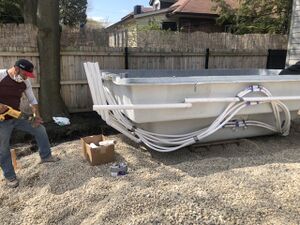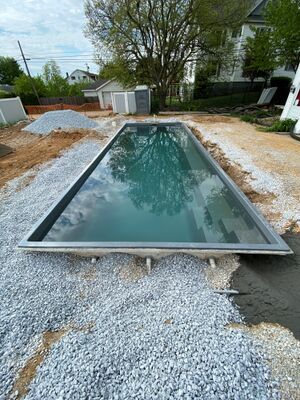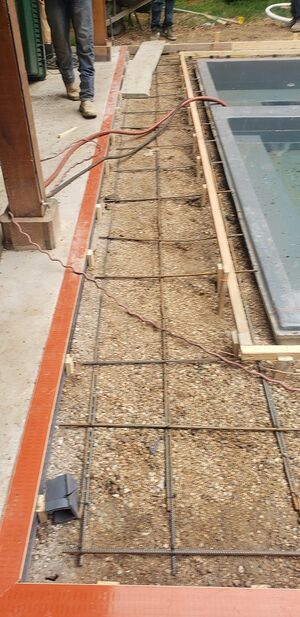- THIS IS A DRAFT WORK IN PROCESS *
Fiberglass Pools
Fiberglass pools may look like the installation should be simple with the pool premade. However the fiberglass pool shell is fragile until properly installed in the ground. There are many ways a fiberglass pool installation can go awry.
Here are some threads to learn about what can go wrong:
And a successful but complex installation:
Construction
Some builders will have the fiberglass pool delivered direct from the manufacturer to the job site and cut everything on site. Others may have the pool delivered to a warehouse and they prep the pool and plumb it before delivering it to the job site. Additional pipe holes can be made on the job site.
With fiberglass, 3/4" stone (no fines) is recommended for leveling the bottom and backfilling the sides.
Install a sump to deal with any water issues if they arise as well as the ability to monitor the ground water level. When you place that much stone around any structure in the ground there is always a possibility of it collecting water from surface or ground. If there are no apparent ground water issues you certainly don't need to place a pump immediately, However I would recommend at least getting a conduit from sump to pad so you can easily wire one up in the future.
Pool should not be shifted after it is set in the level gravel base. Do not let the pool be dragged if not properly placed. A little side to side sliding to settle in would be acceptable but you certainly would not want to see them lifting a side and packing stone under the edge.
When the pool is set double check the levels to make sure things are as you expect with the coping and deck. you should have a clear understanding of how it is set to confirm the pool is at the correct elevation.
It is very important to keep water at the same level as the backfill as it progresses upwards. They are sort of a balance act of wall support against each other, as they go.
When discussing the backfill just ask as a question how "how do you get the gravel all the way under the seat"? Just so they know you will be looking for it. There should be a lot of pushing and packing the stone under the seat. This of course should be done with some water already in the pool. That pool is so light that the could possibly lift it by packing stone under the seat.[1]
I would recommend getting some water in there before any backfilling is done. Just putting stone beside that pool could shift it out of place or even a worker walking by and bumping it. Hopefully you can be present at the backfill. Once the pool has some water in and stone around it I would ask them to just double check the measurement off the walk edge. If it is not parallel with the walk it will stick out like a sore thumb when the finish work is done.
Put a 4' level on the pool edges and check that all sides are level. The industry spec is within 1 inch in 40 feet.
No machine should be within 3 ft of a fully filled and backfilled pool, even more distance when the pool is partially filled. Also, any machine should be a tracked unit not a wheeled machine.
A fiberglass pool gets locked into the ground with a concrete collar. You need a locking collar on a fiberglass pool.[2] It keeps shell in place and there are fiberglass pins that anchor it to the concrete. Make sure they form it well and flush the top to make it easier for coping guy to lay his stone. Cant skip this step.
Normal install is a 12 to 18" ring around pool under the fiberglass lip with pins into the concrete. Some manufacturers require a 3’ locking collar. Check the pool manufacturers installation manual to confirm your requirements.
The coping guy glues to the fiberglass lip and thinsets to the concrete. Then pavers overplayed transitioning to a setting bed or concrete over the whole thing. If you want cantilever coping you can do the coping and ring in one shot keeping it thinner and save on a single pour and coping combo. It's kinda fuzzy but if pool guy is installing pool hes really only doing that and hence his price. The guy doing coping and deck usually does the ring from what I've seen with glass pools as everybody wants it left a different way based on deck material choice
Also make sure the landscaper knows what hes doing and can show you other coping jobs. Coping is the hardest part of the pool build it's not for amateurs that cut grass you want a Mason or hardscape guy.
Fiberglass pool manufacturers include:
- Barrier Reef
- Blue Hawaiian
- Latham
- Leisure Pools
- Viking
Fiberglass Pool Chemistry Levels
Most fiberglass pool manufacturers recommend water chemistry that does not all alight with TFP recommended levels. Often in the FC, TA and CYA ranges.
For decades, the pool industry has published very basic level recommendations in an effort to accommodate all pool types and scenarios. We know this to be poor management as pools require different levels based on their type, equipment, location, amount of sun, etc.[3]
In some locations, an owner may get by with a moderate CYA of 30-40, while in my area, a summer CYA of 50 is almost mandatory and as low as my water can tolerate. Along with that, our staff developed the FC/CYA Chart to show owners how those two items should be balanced together to prevent algae.
Notice we also separate salt pools in that equation. The pool industry as a whole doesn't make that distinction either (salt vs non-salt).
In the pool industry, they just push one generic group of numbers and that's it. Also remember that the pool industry pushes chlorine tablets and encourages the use of various pool store chemical treatments and weekly super-shocks which are generally not required and/or can cause negative side effects to your water.
You can manage to the end of the manufacturer ranges, where they conflict with the TFP ranges, as close to the TFP ranges as possible.
Maintenance
A Fiberglass pool should never be drained. It is very easy for a fiberglass pool to pop out of the ground if empty. If the water needs to be changed use the No Drain Water Exchange process.
Calcium in a Fiberglass pool
Fiberglass pools need calcium. The main function of calcium in the water of a fiberglass pool is to reduce the chance of staining. Primarily Cobalt staining.[4]
Fiberglass Pool Chalking
Gelcoat hazing/fogging may be inevitable for all fiberglass pools. With white fiberglass, you really won't see it because of the color but with colored fiberglass, it's definitely going to show up. Sanding works up to a point but you do want to be careful to use the finest grit that makes a difference and don't go too hard on the gelcoat surface.[5]
You can read all about gelcoat restoration on any boating forum and those guys can get really complicated in their "secret recipes". It's really just the natural degradation of the surface and so you can either accept it and live with it or use it as an opportunity to add some aqua-cardio to your workout routine ☺
One way to minimize the issue would be to install a waterline tile on the fiberglass surface so that the waterline comes halfway up the tile. That way, the entire fiberglass surface is below the water and will uniformly cloud over. It makes it less visually obvious.
Fiberglass Discoloration (Faded & Chalky) - My Story is a case study in dealing with a chalky fiberglass pool.
- ↑ https://www.troublefreepool.com/threads/new-construction-fiberglass-chicago-city-proper.201629/post-1782179
- ↑ https://www.troublefreepool.com/threads/bond-beam-collar-on-fiberglass-pool.194378/post-1713687
- ↑ https://www.troublefreepool.com/threads/new-fiberglass-pool-tfp-vs-manufacturer-levels.199262/post-1759349
- ↑ https://www.troublefreepool.com/threads/first-timer-need-advice-about-calcium.209091/post-1834605
- ↑ https://www.troublefreepool.com/threads/fiberglass-discoloration-faded-chalky-my-story.165467/post-1787386




